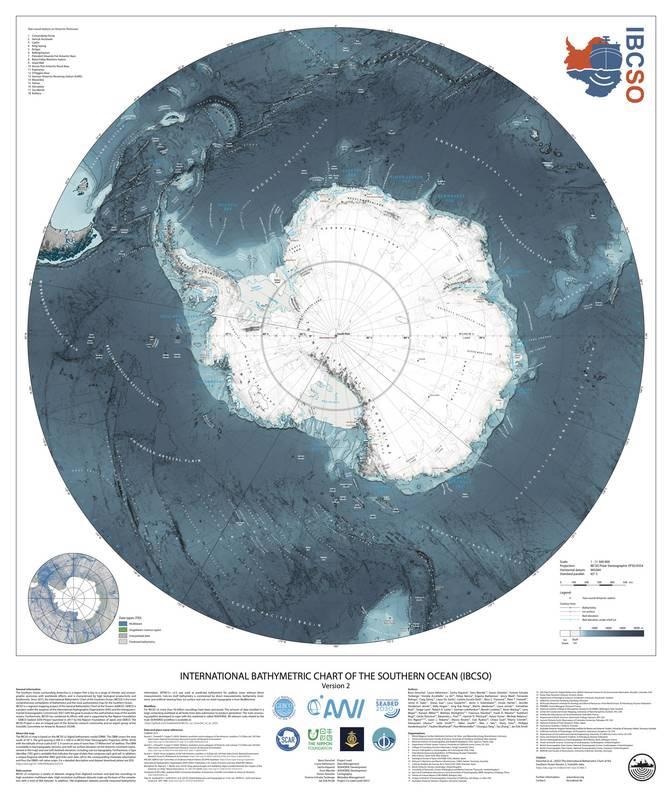The reason behind how the water masses and ocean currents tend to shift and affect climate change has been determined with the help of the features of the ocean floor. Biodiversity is also impacted by seafloor landforms.
 Bathymetric Chart Southern Ocean. Image Credit: Graphic: Simon Dreutter.
Bathymetric Chart Southern Ocean. Image Credit: Graphic: Simon Dreutter.
Hence, having as precise information on the seafloor topography as possible is essential for climate and oceanographic research.
With the help of the second version of the International Bathymetric Chart of the Southern Ocean (IBCSO v2), an international research team headed by the Alfred Wegener Institute currently presented the best and most elaborate seafloor map of the Southern Ocean.
This plays a crucial role in the Earth system. The map and the complicated methods that have been utilized to create it were published in the Nature journal Scientific Data.
Surrounding the Antarctic continent, the Southern Ocean is the main region for the global climate and the Earth system. In this context, the Antarctic Circumpolar Current, forced by strong westerly winds — the disreputable “Roaring Forties” — constitutes the main connecting element present in the globe-spanning thermohaline circulation. This impacts ocean currents in the Atlantic, Pacific, and Indian Oceans.
The cold water of the Southern Ocean also absorbs huge amounts of heat and CO2 from the air, thereby making a temporary buffer for several negative impacts of anthropogenic climate change. Furthermore, these waters have been characterized by high biological productivity and are considered to be home to a special diversity of species.
In spite of its great importance, in the Southern Ocean — as in several other oceans — only relatively few regions of the seafloor have been surveyed and charted elaborately. Even though the satellite data spans the entire ocean, a relatively low resolution has been provided.
At present, high-resolution data can just be collected with the help of ship-based techniques. Consequently, multibeam echosounder readings that are taken in the Southern Ocean by research vessels like the icebreaker Polarstern frequently yield earlier unidentified topographical stresses like a 1,920-m seamount. This was dubbed by the Madiba Seamount in honor of Nelson Mandela’s nickname.
No matter where you travel or work, you need a map for orientation. That’s why virtually all oceanographic disciplines rely on detailed maps of the ocean floor. For example, the seafloor topography of the Southern Ocean is essential to understanding a range of climate-relevant processes.
Dr. Boris Dorschel-Herr, Head, Bathymetry, Helmholtz Centre for Polar and Marine Research, Alfred Wegener Institute
Dorschel-Herr added, “Warm water masses flow into deep troughs in the continental shelf towards the ice shelves and glaciers of the Antarctic, affecting how they melt. Conversely, the stability and calving behavior of glaciers and ice sheets greatly depend on the features of the ground beneath them. With the IBCSO v2, we have delivered the best and most detailed representation of the Southern Ocean to date.”
The International Bathymetric Chart of the Southern Ocean (IBCSO) is known to be an international project that was coordinated by the AWI and tasked with charting the Southern Ocean.
The initial IBCSO digital bathymetric model (IBCSO v1) and high-resolution map of the area south of 60°S were discharged in 2013. In the following years, the amount of new measurement data has significantly increased.
Since 2017, IBCSO has been involved with the Nippon Foundation–GEBCO Seabed 2030 Project, which has set an aspiring goal of surveying all the oceans across the world by 2030.
The new version of IBCSO—IBCSO v2—for the Southern Ocean now covers the entire area south of the 50th parallel—which means 2.4 times as much seafloor as the first version—at a high resolution of 500 by 500 meters.
Dr. Boris Dorschel-Herr, Head, Bathymetry, Helmholtz Centre for Polar and Marine Research, Alfred Wegener Institute
Dorschel-Herr added, “As a result, the Antarctic Circumpolar Current and the key oceanographic ‘gateways’ essential to understanding it—the Drake Passage and the Tasmanian Passage—are included in their entirety. The chart is based on more than 25.5 billion measurements supplied by 88 institutions in 22 countries.”
Journal Reference:
Dorschel, B., et al. (2022) The International Bathymetric Chart of the Southern Ocean Version 2 (IBCSO v2). Scientific Data. doi.org/10.1594/PANGAEA.937574